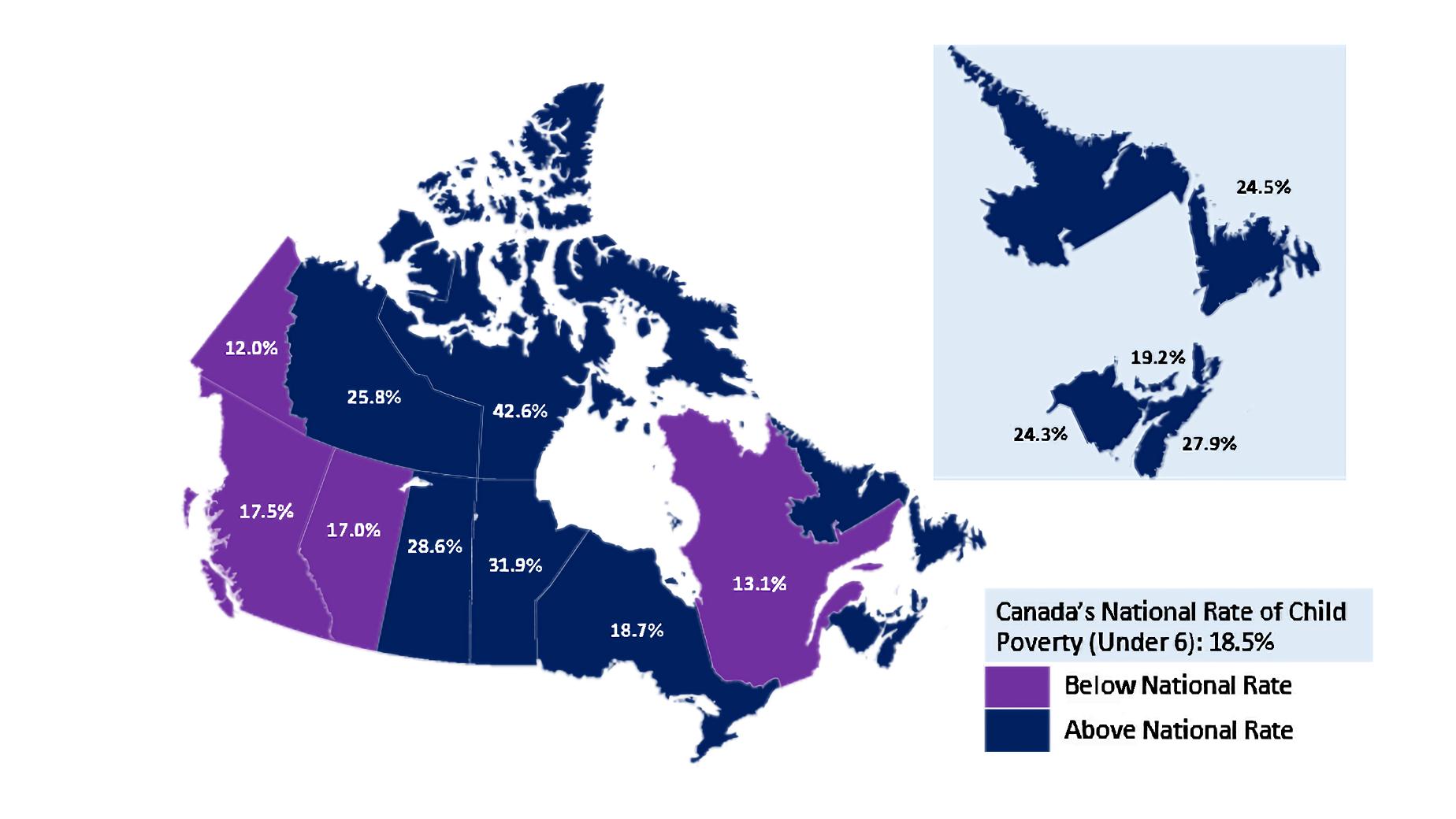
2 minute read
Poverty Among Young Children (Under 6
Poverty impacts approximately one in four (24.3%) children under the age of six in New Brunswick. Poverty is not the result of personal choices. It is a social problem created and sustained by structural barriers and systemic inequity. The negative effects of child poverty can be felt across one?s lifespan. Poverty is an adverse childhood experience that can impose toxic stress, which alters a child?s brain architecture and impacts their development and overall well-being.[22] Early experiences of poverty can contribute to poor health outcomes later in life like addictions and chronic health conditions.[23]
Figure 9: Nat ional Rat es of Child Povert y (Under 6), Canada, Provinces and Territ ories (CFLIM-AT 2019) [24]
It is expensive to raise children, especially when they are young. The Human Development Council?s report on LivingWagesin NewBrunswick2021 reveals that child care is one of the largest expenses for families in Fredericton, Moncton, and Saint John.[25] It is worth noting that toddler child care costs more than before and after school child care. The 2021 living wage calculation for Saint John shows that the cost of full-time toddler day care is roughly $9,000 per year, while before and after school care costs nearly $5,000 per year.[26]
[22] Hughes, M., & Tucker, W. (2018). Povertyasan AdverseChildhood Experience. North Carolina Medical Journal, 79(2). [23] Ibid. [24] Statistics Canada, custom tabulation, T1 Family File, 2019. [25] Atcheson, H. (2021). LivingWagesin NewBrunswick2021, https://sjhdc.ca/living-wage/ [26] Ibid.
Table 2: 2020 m edian infant , t oddler and preschool m ont hly child care fees in Frederict on, Monct on and Saint John [27]
Frederict on Monct on Saint John
Infant $835 $856 $868
Toddler $716 $716 $716
Preschool $690 $716 $697
The Designated Centre Parent Subsidy is available to support low- and middle-income families with preschool aged children.[28] Families with household incomes of $37,500 or less are eligible to receive free early learning and child care services at a licensed centre. Families with incomes between $37,501 and $80,000 are eligible to receive a partial subsidy. The eligibility criteria to receive a subsidy includes household income, as well as other factors like the daily child care fee and the number of days the child requires child care services.
In Canada, 44% of non-school age children live in a "child care desert, " meaning that there are three children in potential competition for every licensed child care space.[29] In Saint John, there are only enough licensed child care spaces for 47%of the city's non-school age children.[30]
According to the Surveyon EarlyLearningand Child CareArrangements, 2020, "approximately 4 in 10 parents who were using regulated or unregulated child care in late 2020 reported having had difficulty finding child care. "[31] Parents with children aged 1 to 3 were most likely to report child care challenges. Parents reported difficulties accessing local and affordable child care. They also reported that the COVID-19 pandemic made it even more difficult to find and maintain a stable child care arrangement. The provincial government has not yet reached an agreement with the federal government about the implementation of a $10-a-day universal child care program in New Brunswick.
[27] Macdonald, D., & Friendly, M. (2021). SoundingtheAlarm:COVID-19?simpact on Canada?sprecariouschild caresector. (Ottawa: Canadian Centre for Policy Alternatives). https://www.policyalternatives.ca/TheAlarm
[28] Government of New Brunswick,
"Designated Centre - Parent Subsidy, " https://www2.gnb.ca/content/gnb/en/corporate/promo/improved _ early_ learning_ and _ child _ care/dcs _ info.html
[29] Macdonald, D. (2018). Child CareDesertsin Canada. (Ottawa: Canadian Centre for Policy Alternatives). https://www.policyalternatives.ca/publications/reports/child-care-deserts-canada
[30] Ibid.
[31] Statistics Canada, Surveyon EarlyLearningand Child CareArrangements, 2020, https://www150.statcan.gc.ca/n1/daily-quotidien/210407/dq210407b-eng.htmhttps://www150.statcan.gc.ca/n1/dailyquotidien/210407/dq210407b-eng.htm










